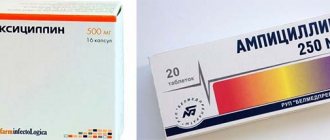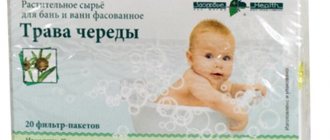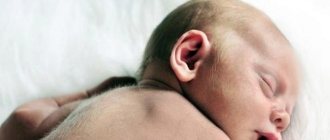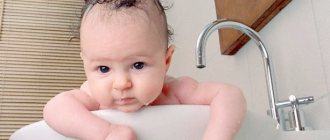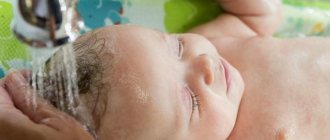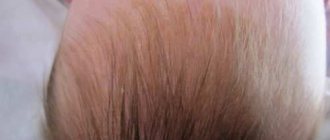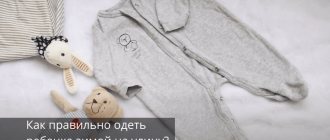Features of newborn skin
- the skin of a newborn is very thin and delicate, it is three times thinner than the skin of an adult, and its outer layer contains actually one thin layer of cells;
- it is susceptible to irritation and infection, because the ratio of the baby’s skin area to its weight is three times greater than that of an adult, and the blood supply to the skin is 1.5 times higher than that of an adult;
- water and minerals are very intensively released from the skin of a newborn baby;
- the intensity of a baby’s skin respiration is 8 times stronger than that of an adult: he literally “breathes through his skin”; however, when dirt appears on the baby’s skin, the child is deprived of this opportunity;
- infant skin is easily injured;
- the protective functions of the skin of a newborn baby are reduced due to the fact that the mechanism for producing fats in it has not yet been developed, as a result of which the sebaceous and sweat glands almost do not work;
- The baby’s skin has a very high absorption capacity, and during the inflammatory process it increases significantly; for this reason, intoxication of the newborn’s body occurs very quickly;
- The melanin content in infant skin is very low, so it is vulnerable to ultraviolet rays;
Why do newborns' skin peel?
Because due to its thin structure, a baby’s skin loses moisture very quickly and dries out even with the slightest increase in temperature. If your baby overheats (during the summer months or in a too warm room), his skin quickly becomes covered with “islands” of prickly heat - a pink rash.
Essential knowledge about newborn skin
The baby’s skin is not fully mature; it is very different from adults, beginning to resemble them only in the third year of life:
- In full-term newborns, the epidermis is only slightly thinner and more delicate than in adults;
- The skin acidity pH value equal to 5.4-5.9 (as in an adult) is achieved after 2-2.5 months;
- The baby's epidermis produces little pigment and is therefore more sensitive to the sun;
- There are fewer sweat glands in the skin, their activity is much lower, so children adapt less well to high temperatures and are prone to overheating;
- Hair growth and hair loss in infants are synchronized, which is associated with the temporary “baldness” of a child at the age of several weeks;
- The ratio of the surface area of the epidermis to body weight is higher in infants, so children lose a lot of water as a result of its evaporation through the skin and are prone to greater absorption of drugs and chemicals when they come into contact with the skin.
Features of the skin of premature babies
In premature babies, the skin has the following features:
- thinner and more tender than those of children born at term;
- blood vessels are visible through the immature epidermis;
- the lipid layer that protects the skin from damage is almost completely absent;
- The pH of the skin is 6.3-6.7, which contributes to the spread of bacterial and fungal infections.
Important! In premature babies, toxins, bacteria and substances contained in baby cosmetics penetrate more easily through the skin, which affects the general condition of the baby. These children are more susceptible to skin irritations caused by urine and feces.
Newborn baby skin color
During the first days of life, the skin of a newborn is covered with a special vernix lubricant, similar to cottage cheese: it consists of glycogen, extractives, fat, salts, cholesterol, as well as vitamins and other substances. This layer gradually disappears as a result of drying, using clothes and diapers.
The skin color of a newborn is most often reddish with a bluish tint, while its skin is slightly swollen. You can see a small fuzz of hair on the baby's skin. And the skin of a newborn’s face on the nose and adjacent areas is covered with milia - small white-yellow pimples. After 2-3 days of life, the skin color of a newborn may acquire a yellowish tint: this is due to increased destruction of red blood cells and immaturity of liver enzymes.
Let's go for a walk
If the child is healthy, you can walk with him from the first day of life. Regarding children's walks, the rule “nature has no bad weather” is true. You can cancel a walk only if there is severe frost, abnormal heat or other extreme weather conditions outside. In bad weather, you can take the cradle and baby out onto the balcony.
Read also
The child does not have enough milk: what to do, how to increase lactation
Usually babies sleep in a stroller, so the mother can choose the time for a walk at her discretion. It is better to start walking for 30-40 minutes, gradually increasing the walking time. Over time, you can walk up to 4-6 hours a day, dividing this time into 2 “calls”.
The most important thing is to dress your baby for the weather, take wet wipes, a change of diaper and a rain cover for the stroller.
Newborn baby skin care
Until the age of six months, the baby must be bathed daily, but you should not leave him in the water for a long time (more than 5-10 minutes). Immediately after bathing, it is necessary to treat the still wet skin of the baby’s face and the scalp of the newborn with special milk or oil, and only then can it be wiped with light blotting touches. The so-called products for “bathing without tears” are not a whim of modern mothers, but an important part of caring for a child’s skin, because by choosing these products, you preserve the lipid barrier in the child’s skin and protect it from serious damage. Shampoo “without tears” for the scalp of a newborn baby should be used no more than 1-2 times a week, and cream-gel should be used for daily bathing.
Expert comment:
Dermatologists try not to prescribe antiseptics, alcohols, urea, and salicylic acid to treat the baby’s skin. After all, all these substances very quickly penetrate the baby’s skin and quickly end up in the bloodstream. Infant dry skin is a normal condition that affects one third of children. Sometimes the skin contains not only peeling, but also microcracks, which are also a normal physiological condition.
How to properly wash a newborn
You will need cotton balls and flagella. We moisten everything in boiled water. We start with treating the eyes: rub the ball without pressing from the outer corner to the inner. Then wipe the outside of the nose with the ball and clean the inside of the nostrils with the flagellum. We treat the ears with a flagellum, removing wax from the skin of the external auditory canal. It is not worth pushing the flagellum deeper, since the wax is not removed, but is pushed inside the ear canal. It is enough to clean your ears 2 times a week. Wipe the skin behind the ears and face with a cotton ball. The umbilical wound should be treated 2 times a day with a 3% solution of hydrogen peroxide, then with brilliant green.
Newborn skin care: why does it need special care?
Expert comment: First of all, because the skin is very delicate, and as a result of this, various dermatitis often develops on it. In addition, the condition of the child’s skin directly depends on the presence or absence of infectious diseases among parents and caregivers. The risk of infection of the baby's skin is very high, since at birth the child has wound surfaces, and their main focus is concentrated in the umbilical wound. With inadequate care of a child's skin, the pH of which is slightly acidic, its balance quickly shifts to the alkaline side.
When caring, it is necessary to pay special attention to the numerous folds on the skin of a newborn baby, especially if the baby is overweight: after all, infected diaper rash is essentially the result of poor care of the baby, untimely treatment of his skin after contact with urine and feces. Parents should remember that it is in infancy that the immune system is formed and allergic reactions occur. This includes atopic dermatitis, which begins with damage to the skin barrier.
How to properly care for your baby's skin:
- limit contact with biological fluids: feces, urine, sweat, saliva;
- to prevent diaper rash, use zinc-containing products - both under the diaper and for treating skin folds;
- use only those children's cosmetics that soothe the skin and enhance its regeneration;
- choose only hypoallergenic baby skin care products that contain components similar to physiological ones and also soothe the skin and have a mild anti-inflammatory effect;
- Children's cosmetics should be suitable for care from “zero” age.
Children's cosmetics for treatment must exclude harmful components:
- Phthalates are fragrances that dampen the unpleasant odor of the product base associated with a petroleum product. Phthalates can cause asthma, infertility, decreased testosterone concentrations in boys, and delay puberty in girls during puberty. Due to side effects, some types of phthalates are banned in the US and EU countries.
- Parabens are preservatives that prevent the development of microorganisms in cosmetics and, as a result, disrupt the skin microbiome. Parabens may have a weak estrogenic effect, penetrate the skin and accumulate in the body. Subsequently, they can cause the development of breast cancer and miscarriage.
- Surfactants (surfactants) that are responsible for the “foaminess” of shampoos and other detergents. They remove not only dirt and fats, but also the skin’s own lipid layer. These products are especially dangerous for children with atopic dermatitis, as they severely irritate the skin.
What cosmetics should you choose when caring for your baby’s skin:
- with cotton extract, which has protective, softening and nourishing properties;
- with lanolin - a wax of animal origin that preserves the lipid barrier of the skin;
- with panthenol, which restores and moisturizes the skin;
- with wheat proteins, which restore the protective barrier of dry skin in a newborn;
- with soybean oil, which promotes skin regeneration;
- with aloe vera, which stimulates and heals the skin;
- with grape seed oil - a natural antioxidant.
What exactly is needed when treating a newborn’s skin:
- massage oil with a soft and light emollient (a substance that helps soften dry skin in a newborn);
- if deeper hydration is required, a special baby cream will work well - but one that does not leave a wet film on the child’s skin (to avoid this, cotton extract and highly purified lanolin are added to high-quality creams);
- In winter, classic cold creams containing a significant amount of water in oil will help protect the dry skin of a newborn from the effects of various external factors (these creams can also treat the skin of a newborn’s face);
- care when changing a diaper involves the use of a zinc-containing and anti-inflammatory agent.
Washing
This is one of the frequent procedures during the day, aimed at cleansing the skin after physiological functions. The diaper (diapers) should be changed as soon as “big” things happen and at least every time. You can wash the baby under the tap, not forgetting that girls are washed from front to back. To cleanse the skin, you can use baby soap, which has a neutral pH and does not dry out the skin, but, on the contrary, softens it thanks to natural additives. At each stage of a child’s growth, you can choose the soap that suits him, based on the properties of the plant components it contains. Bulgarian manufacturers pay special attention to the healing properties of rose water, which has a regenerating and softening effect, in children's cosmetics ROSE of BULGARIA kid'S, the antiseptic and antibacterial effect of chamomile and wigwood extracts (Lavena Baby Hedgehog series).
Read also
Hyperthermia in children: what it is and methods of emergency treatment of the disease
Recommendations for baby skin care in summer
To make your baby feel comfortable, in the summer you need to:
- bathe the baby more often;
- completely undress the child, free him from the diaper for a while;
- Wash your child after every bowel movement and urination.
Do not use cosmetic products unnecessarily.
Bathing and air baths
If your child is prone to skin problems, then bathe him several times a day, but use detergents only once.
Follow the rules for taking water procedures:
- water temperature not higher than 37 degrees;
- The duration of bathing is no more than a quarter of an hour.
If your baby has heat rash or irritation, add decoctions of plants to the water: strings, chamomile, calendula. Oak bark has a drying, tanning effect, and in turn has an antiseptic and anti-inflammatory effect.
After washing, apply moisturizing milk or non-greasy cream to your child's skin. If you do not have the opportunity to bathe your baby often, wipe his skin with wet wipes or a wet towel.
In the sultry heat, it is important to allow the little one to walk without clothes or a diaper. So, you harden the baby, improve his thermoregulatory system.
Care for skin folds
Almost all babies have folds of skin on their legs, arms and necks, in which diaper rash, wetness, and rashes often form.
Frequent regurgitation, leakage of milk, physiological secretions and friction lead to diaper rash and inflammation in these areas. Discomfort may be accompanied by pain.
Inexperienced mothers do not know how to treat folds in a newborn, and they start the problem.
Folds can be processed:
- baby powder;
- lubricate with baby oil or boiled vegetable oil;
- baby cream
The choice of product depends on the skin problem. If your baby has dry skin, take oil, and if the folds get wet, dry them with powder.
Do not use powder and oil at the same time - this provokes an inflammatory process.
Facial skin care
The face also requires daily care. It sweats, is exposed to dust and sunlight. Wipe the baby's face with a cotton pad dipped in water.

Clean the nasolabial area, corners of the mouth and the space behind the ears especially thoroughly.
Before going outside in the summer, apply sunscreen for children to your face and body. It should have maximum protection against ultraviolet radiation. Don't forget about your headdress.
